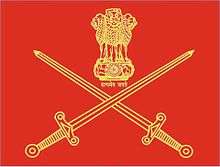III Corps (India)
| III Corps | |
|---|---|
| Active |
1915–1919? 1941–1942 1980s–present |
| Country |
|
| Branch |
|
| Type | Army Corps |
| Role | Counter-insurgency |
| Size | Corps |
| Part of | Eastern Command |
| Garrison/HQ | Dimapur |
| Commanders | |
| Current commander | Lieutenant General Abhay Krishna |
The III Corps was a formation of the Indian Army during World War I formed in Mesopotamia. Prior to the reorganization of the British and Indian forces in Mesopotamia, it was designated as the Tigris Corps. It is located in the state of Nagaland of India in the city of Dimapur. The military station is known as Rangapahar Military Station.
A new III Corps was formed by the Indian Army during World War II for service in Southeast Asia. The corps fought in the Battle of Singapore where it surrendered in February 1942.[1]
| Indian Army Corps (1947 - Present) | |
|---|---|
| Previous | Next |
| II Corps | IV Corps |
First World War
Initially formed in December 1915, it was split into two in November 1916 to form the I Corps.[2] Under Frederick Stanley Maude it took part in the Mesopotamian campaign.
Among its component divisions during World War I were the Cavalry Division, 3rd (Lahore) Division, 6th (Poona) Division, 7th (Meerut) Division, 12th Indian Division, 14th Indian Division, 17th Indian Division, and 18th Indian Division.
Second World War
The Indian III Corps was the primary ground formation that took part in the Malayan Campaign in 1942. It was commanded by Lieutenant-General Sir Lewis "Piggy" Heath. The Corps also included a Gurkha regiment, 1 Gorkha Rifles.
Indian III Corps was formed in mid-1941 as part of the Malaya Command when the increase in tension in the Far East necessitated the dispatch of large reinforcements to the area to deter Japan. On 7 December 1941 the Corps consisted of the Indian 9th Infantry Division, commanded by Major-General Arthur Edward Barstow, the Indian 11th Infantry Division, commanded by Major-General David Murray-Lyon, a lines of communication Area, and the Penang Fortress.[3] Due to the rapid expansion of the British Indian Army, many of the formations in the Indian divisions were ill-trained and lacked large enough cadres of experienced troops.
The British had plans – Operation Matador and Operation Krohcol – to move forward into the south of Siam to forestall Japanese advances. However, lack of forewarning, combined with caution over upsetting Japan needlessly with precipitate actions, prevented the plans from being implemented. This put the garrison on the defensive, a position from which it never recovered.
III Corps was pushed down the Malayan peninsula by Japanese units, who employed novel tactics. When confronted with an Allied strong point on a road, the Japanese troops would leave a screen in front of the position, and then send infiltrators round through the jungle to outflank the position. Having been surrounded, positions were usually relatively easy to take. III Corps and the rest of the Allied land forces were pushed back to Singapore itself by February 1942. There they endured a short siege before the island surrendered at the direction of Lieutenant-General Arthur Ernest Percival. Some of the prisoners taken from Indian III Corps subsequently joined the Indian National Army.
Post independence
After the independence of India, a new III Corps was raised by the Indian Army in the 1980s. It is based at Dimapur in north east India, and contains mountain formations and is tasked for use in any future Indian war against China. Jane's estimates that it consists of:[4]
- 23rd Infantry Division headquartered at Ranchi, Jharkhand. Raised 1963.[5]
- 56th Infantry Division headquartered at Zakhama, Nagaland Reportedly operational October 2009.[6] Includes 46 Brigade (Dibang) and the 22 Brigade (Lekhapani), though 22 Brigade may shift to 2nd Mountain Division.
- 57th Mountain Division headquartered at Leimakhong. Raised in 1966 for counterinsurgency operations in Mizoram. Until 1990 headquartered at Aizawi with III Corps.[5] Globalsecurity.org reports the 57 Mountain Division headquarters are at Masimpur near Silchar.[7] The formation and units of 57 Mountain Division are deployed in some of the remotest corner of Manipur and Indo-Burmese border.[8] 57th Mountain Division took part in the Indo-Pakistani War of 1971 as part of IV Corps (India). It also successfully conducted Operation Golden Bird in 1995 to eliminate rebels in Northeast India.[9]
Reference list
- ↑ Ramakrishna
- ↑ Listing of British Corps, accessed July 2010
- ↑ Orbat.com/Niehorster, III Indian Corps, 7 December 1941
- ↑ Jane's World Armies, Issue 19, 2006
- 1 2 Conboy, Elite Forces of India and Pakistan, p.8
- ↑ http://chhindits.blogspot.com/2009/11/armys-first-mountain-division-for-china.html, 11 November 2009
- ↑ Globalsecurity.org, 17 July 2010
- ↑ http://www.globalsecurity.org/military/world/india/57-div.htm
- ↑ "Troubled Periphery: The Crisis of India's North East By Subir Bhaumik".
External links
- Australian War Memorial: Remembering 1942 The fall of Singapore, 15 February 1942
- III Indian Corps History & Personnel
- http://www.orbat.com (History; Niehorster)
